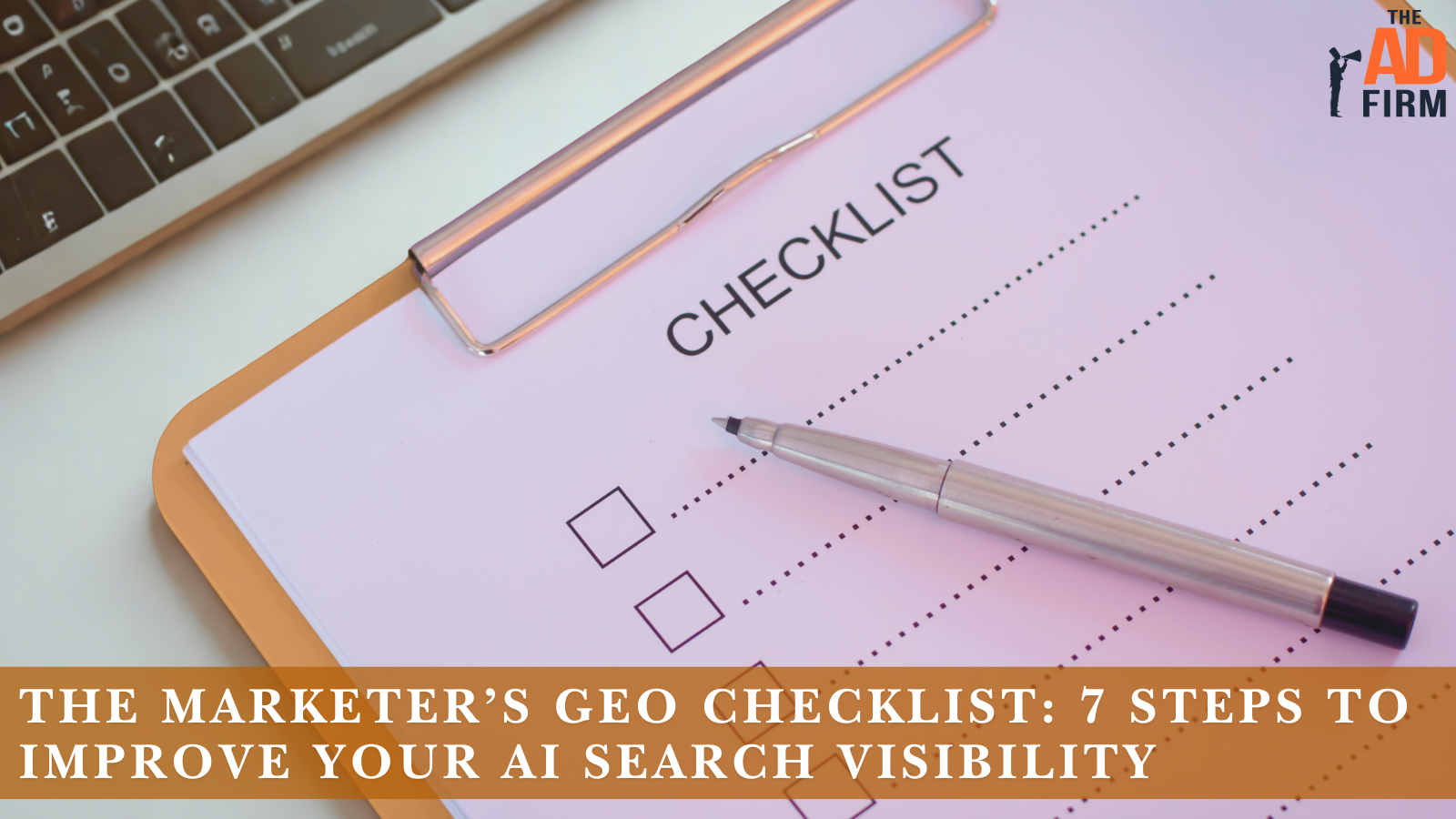Search engines are no longer just about ranking on page one. AI platforms like ChatGPT, Google’s AI Overviews, Perplexity, and Bing Chat are reshaping how customers discover businesses, making traditional SEO strategies only half the battle. Generative engine optimization (GEO) is the strategic approach to getting your brand cited and recommended within AI-generated responses, transforming how you capture demand in an AI-first search landscape.
This seven-step GEO generative engine optimization checklist provides marketers with a clear, actionable roadmap to dominate AI search visibility, drive qualified traffic, and convert prospects who are already primed to make a purchase.
Understanding GEO and the 7-Step Framework
Traditional SEO focused on optimizing for crawlers, ranking for keywords, and earning backlinks to achieve top 10 search results. The goal was visibility among links. Generative SEO changes that. Instead of competing for placement, the objective is to become the source AI uses when delivering a synthesized answer in ChatGPT or Google’s AI search.
This shift requires content that is clear, credible, and demonstrates expertise rather than relying on keyword density or backlink volume. While technical basics like site speed, mobile optimization, and crawlability still matter, GEO introduces new priorities: schema markup to define meaning, FAQ formats that mirror user questions, and transparent data that builds trust.
To put this into action, we use a practical 7-step GEO framework. Built for marketers who need results, not theory, each step offers clear actions you can implement immediately to improve AI search visibility. This is the same playbook top AI SEO agencies use to dominate generative search.
1. Audit Your Current AI Search Visibility
You can’t improve what you don’t measure. Most businesses have no idea where they currently stand in AI search results. This first step eliminates that blind spot by discovering exactly how often your brand is mentioned, in what context, and compared to which competitors.
Test Brand Mentions Across AI Platforms
Start by manually testing how AI platforms respond to queries related to your industry, services, and location. Open ChatGPT, Google’s AI Mode, Perplexity, and Bing Chat. Ask questions the way a real customer would: “What’s the best digital marketing agency for small businesses?” or “Who offers reliable AI SEO services in my area?”
Boost Your Business Growth with The Ad Firm
- PPC: Optimize your ad spends with our tailored PPC campaigns that promise higher conversions.
- Web Development: Develop a robust, scalable website optimized for user experience and conversions.
- Email Marketing: Engage your audience with personalized email marketing strategies designed for maximum impact.
Record these details:
- Does your brand appear at all?
- What position is it mentioned?
- What context surrounds your citation?
- Which competitors are consistently cited instead?
Pay attention to the language AI uses when describing your competitors. Are they called “trusted,” “reliable,” or “expert”? These descriptors reveal the signals AI is picking up across the web. Document your findings with screenshots and timestamps for future comparison.
Benchmark Against Competitors Using AI Tools
Manual testing gives you qualitative insights, but you need quantitative data to build a strategy. Tools like Semrush’s AI Insight Optimizer (AIO) and RankScale.ai allow you to track how frequently your brand appears in AI responses compared to competitors. These tools simulate thousands of queries, measuring citation frequency, sentiment, and positioning.
Set up competitor tracking for at least three to five businesses in your industry or niche. Choose direct competitors who serve the same audience and offer similar services. Watch for patterns:
- Do they dominate informational queries but miss transactional ones?
- Do they appear more often in local searches than broader industry questions?
- What query types are they ignoring completely?
These gaps represent opportunities to claim visibility they’re leaving on the table.
Document Baseline Metrics for Future Tracking
Create a simple dashboard or spreadsheet that captures your current AI visibility metrics. Include total brand mentions, citation frequency across platforms, sentiment analysis, and competitor comparison data. This baseline is your starting point for measuring progress every 30 days.
Consistency is critical. Use the same queries, platforms, and tracking tools each time you audit to ensure your data is comparable month over month. When you can show that brand mentions increased by 40% in 60 days, you’ve built undeniable proof of ROI. Generative engine optimization is still relatively new, so most decision-makers need to see the numbers to believe in the strategy.
2. Target High-Intent Local and Geo Keywords
AI search is inherently conversational, which means users ask questions with local and geographic intent far more often than in traditional search. Someone using ChatGPT might ask, “Which AI SEO agency near me has the best reviews?” or “Where can I find reliable generative AI search engine optimization help in my city?” These hyperlocal, long-tail queries are gold for businesses ready to capture them.
Strengthen Your Online Authority with The Ad Firm
- SEO: Build a formidable online presence with SEO strategies designed for maximum impact.
- Web Design: Create a website that not only looks great but also performs well across all devices.
- Digital PR: Manage your online reputation and enhance visibility with strategic digital public relations.
Targeting the right geo-specific keywords directly positions your brand within AI-generated results for local searches, making your business the answer AI provides when users ask location-based questions.
Discover Location-Specific Long-Tail Query Opportunities
Utilize AI-powered keyword research tools, such as SEMrush, Ahrefs, or AnswerThePublic, to uncover the long-tail, location-based questions your audience is actually asking. Look for phrases that combine your service with geographic indicators: “best AI SEO services in [city]” or “top digital marketing agency for [industry] in [region].”
These queries often have lower search volume than broad keywords, but they convert at significantly higher rates because they indicate immediate intent. A user asking for local options is ready to take action now, not later.
Don’t limit yourself to city names:
- Dig into neighborhoods and regional identifiers
- Mention landmarks that customers use as reference points
- Include business districts or corridors with a strong identity
- Reference geographic features unique to your service area
AI models are trained to understand geographic context, so mentioning specific locations helps AI connect your brand to local searches.
Align Content with User Search Intent
Not all keywords have the same intent, and AI can distinguish between them. Your content needs to match the intent behind each query, or AI will skip over you in favor of a source that better answers what the user actually wants.
Informational queries, such as “What is generative SEO?”, require educational content that clearly explains concepts. Navigational queries, such as “The Ad Firm AI SEO contact,” indicate that someone is already looking for you specifically. Transactional queries, such as “hire AI SEO agency” or “get generative engine optimization services,” signal purchase readiness.
Create dedicated pages or sections for each intent type:
- Build comprehensive guides and FAQs to capture informational searches
- Optimize your homepage, about page, and contact page for navigational queries
- Develop service pages with transparent pricing, process explanations, and strong calls to action for transactional intent
When AI scans your site, it should find precisely what it needs to answer the user’s question.
Elevate Your Market Presence with The Ad Firm
- SEO: Boost your search engine visibility and supercharge your sales figures with strategic SEO.
- PPC: Target and capture your ideal customers through highly optimized PPC campaigns.
- Social Media: Engage effectively with your audience and build brand loyalty through targeted social media strategies.
Focus on Hyperlocal Keywords That Convert
Hyperlocal keywords are the secret weapon of savvy marketers using Generative Engine Optimization. These terms extend beyond city-level targeting to include specific streets, zip codes, business districts, or even proximity to competitors.
Integrate hyperlocal keywords naturally into your content, Google Business Profile, and local citations to enhance your online presence. Mention landmarks, cross streets, and nearby attractions that customers use as reference points. If you’re located “two blocks away” or “serving the downtown business district,” say so clearly.
ALSO READ: AI for Multilingual SEO: Scaling Content for Global Reach
3. Optimize Technical Foundations for AI Readability
AI can’t recommend what it can’t understand. Your technical infrastructure determines whether AI platforms can access, crawl, interpret, and trust your content enough to cite it accurately. Speed, mobile performance, schema markup, and crawlability form the foundation on which everything else is built.
Ensure Speed, Mobile-Friendliness, and Schema Markup
Page speed directly impacts if AI platforms will crawl and index your content efficiently. Slow sites get deprioritized because AI models favor sources that deliver information quickly and reliably. Run your site through Google PageSpeed Insights and GTmetrix to identify bottlenecks.
Quick wins for speed improvement:
- Compress images and enable lazy loading
- Enable browser caching and minimize CSS/JavaScript
- Consider a content delivery network (CDN) for national audiences
- Upgrade hosting if server response time exceeds 200ms
Mobile optimization is non-negotiable. Test your site on multiple devices to ensure responsive design, readable fonts, and touch-friendly navigation. Schema markup is equally critical because structured data tells AI exactly what your content is about using standardized vocabulary that eliminates ambiguity.
Implement schema for:
- FAQs and Q&A sections
- Local business information
- Articles and blog posts
- Reviews and ratings
- Products and services
Tools like Google’s Rich Results Test and Schema Markup Validator help you confirm everything is implemented correctly. Additionally, check your robots.txt file to ensure you’re not accidentally blocking AI crawlers. Common culprits include overly restrictive disallow rules that prevent bots from accessing important pages.
Advance Your Digital Reach with The Ad Firm
- Local SEO: Dominate your local market and attract more customers with targeted local SEO strategies.
- PPC: Use precise PPC management to draw high-quality traffic and boost your leads effectively.
- Content Marketing: Create and distribute valuable, relevant content that captivates your audience and builds authority.
Use tools like Screaming Frog, Sitebulb, or SEMrush’s Site Audit feature to identify:
- Crawl errors and broken links
- Orphaned pages without clear navigation paths
- Redirect chains that slow crawler access
- Pages blocked by robots.txt or noindex tags
Review your server logs to see which bots are actually visiting your site. Look for crawlers including GPTBot (OpenAI), Google-Extended (for AI training), and ClaudeBot (Anthropic). If you’re blocking these accidentally, you’re voluntarily opting out of AI visibility.
Verify AI Crawler Access to Pages
Not all crawlers are created equal, and AI platforms use their own bots to access and index content. Check your robots.txt file to ensure you’re not accidentally blocking AI crawlers. Common culprits include overly restrictive disallow rules that prevent bots from accessing important pages.
Use tools like Screaming Frog, Sitebulb, or SEMrush’s Site Audit feature to identify:
- Crawl errors and broken links
- Orphaned pages without clear navigation paths
- Redirect chains that slow crawler access
- Pages blocked by robots.txt or noindex tags
Review your server logs to see which bots are actually visiting your site. Look for crawlers including GPTBot (OpenAI), Google-Extended (for AI training), and ClaudeBot (Anthropic). If you’re blocking these accidentally, you’re voluntarily opting out of AI visibility.
Incorporate E-E-A-T Signals for Credibility
Experience, Expertise, Authoritativeness, and Trustworthiness (E-E-A-T) are the pillars that AI platforms use to evaluate the credibility of sources. These signals determine if AI will confidently cite your content or skip over it for a more trustworthy alternative.
Add detailed author bios with credentials, certifications, and relevant experience to every blog post and article. Link to professional profiles, LinkedIn pages, and other verification sources that prove your expertise. The more AI can verify your qualifications, the more likely it is to recommend your content.
Publish original research, case studies, and proprietary data that position your brand as a primary source. AI models prioritize first-hand information over aggregated or rehashed content. If you’re a digital marketing agency, share campaign results, industry surveys, or client success metrics that you can provide alone.
Enhance Your Brand Visibility with The Ad Firm
- SEO: Enhance your online presence with our advanced SEO tactics designed for long-term success.
- Content Marketing: Tell your brand’s story through compelling content that engages and retains customers.
- Web Design: Design visually appealing and user-friendly websites that stand out in your industry.
Back up every claim with citations to authoritative sources:
- Academic studies and research papers
- Government data and official reports
- Recognized industry publications
- Primary source documentation
External links to credible sources don’t dilute your authority but reinforce it by showing AI that you’re grounded in verifiable facts.
ALSO READ: Future-Proofing SEO with AI: How to Stay Ahead of Algorithm Changes
4. Create AI-Friendly Content Aligned with Prompts
Content is still king, but the rules have changed. AI doesn’t reward keyword density or clever copywriting but clarity, structure, and direct answers to user questions. Your content needs to be conversational enough to match how people ask questions, detailed enough to satisfy AI’s need for comprehensive answers, and formatted so AI can extract and cite specific sections without confusion.
Craft Conversational Answers to AI Queries
AI search is fundamentally question-based. Users ask, “How do I improve my generative search optimization?” or “What makes a great AI SEO agency?” Your content needs to answer these questions directly using natural language that mirrors how people speak.
Structure your content with question-based headings whenever possible. Instead of “Benefits of AI SEO,” use “Why Does AI SEO Matter for Your Business?” This aligns your content with the exact phrasing users employ when asking AI platforms for help.
Within each section:
- Provide a concise, direct answer in the first paragraph
- Expand with supporting details and examples
- Include context that reinforces your expertise
This front-loaded approach ensures that even if AI only extracts the first few sentences, the user still gets a complete answer.
Use NLP Insights for Entity-Rich Content
Natural Language Processing (NLP) is how AI understands relationships between concepts, entities, and topics. Tools like SEMrush’s Topic Research can reveal the entities and related terms AI expects to see in high-quality content. If you’re writing about search generative experience optimization, AI expects you to mention related entities like “Google AI Overviews,” “ChatGPT,” “schema markup,” and “conversational search.”
Amplify Your Market Strategy with The Ad Firm
- PPC: Master the art of pay-per-click advertising to drive meaningful and measurable results.
- SEO: Elevate your visibility on search engines to attract more targeted traffic to your site.
- Content Marketing: Develop and implement a content marketing strategy that enhances brand recognition and customer engagement.
Incorporate semantic keywords and related entities naturally throughout your content. When discussing generative AI search engine optimization, it is sensible to mention specific AI platforms, optimization techniques, and measurable outcomes. This semantic richness helps AI understand context and classify your content accurately.
Format for Easy AI Snippet Extraction
AI platforms extract snippets, not entire pages. Your formatting determines how easily AI can pull the exact information it needs to answer a user’s question. Use short paragraphs of two to three sentences maximum.
Break up long blocks of text with:
- Subheadings that preview content
- Bullet points for lists and steps
- Numbered lists for sequential processes
- Tables and comparison charts for data
- FAQ sections with clear question-and-answer pairs
Bold key phrases and statistics to signal importance. Think of each section as a standalone answer that could be extracted and cited independently. If AI pulls just one paragraph, will it still make sense to the user? If yes, you’ve formatted correctly.
5. Build Trust and Get Cited
Being cited by AI platforms requires more than quality content. It demands verifiable credibility. AI won’t recommend sources it considers unreliable, unverified, or low quality. Trust is earned through consistent social proof, authoritative validation, and transparent information that AI can verify across multiple sources.
Earn Reviews, Expert Mentions, and Backlinks
Reviews signal credibility to AI, especially when they’re consistent, detailed, and recent. Encourage satisfied customers to leave reviews on Google, Trustpilot, G2, Capterra, and industry-specific platforms. AI crawls these sources and uses review sentiment as a trust indicator.
Make review generation a systematic part of your customer experience:
- Send follow-up emails requesting reviews after project completion
- Make the process easy with direct links to review platforms
- Respond to every review to show you’re engaged and responsive
Expert mentions and authoritative backlinks function as endorsements. When respected publications, industry blogs, or thought leaders cite your business, AI interprets that as validation. Focus on earning backlinks from high-authority domains in your industry by contributing guest posts, getting featured in industry roundups, and participating in expert panels or podcasts. These external validations create a web of credibility that AI recognizes and rewards with citations.
Transform Your Online Strategy with The Ad Firm
- SEO: Achieve top search rankings and outpace your competitors with our expert SEO techniques.
- Paid Ads: Leverage cutting-edge ad strategies to maximize return on investment and increase conversions.
- Digital PR: Manage your brand’s reputation and enhance public perception with our tailored digital PR services.
Demonstrate Authority Through Original Research and Transparent Data
AI platforms prioritize primary sources, meaning businesses that generate original data get cited more often than those that simply comment on someone else’s research. Conduct surveys, publish case studies, release industry reports, or share proprietary performance metrics. When you’re the source of the data, AI has to cite you by default.
Transparency builds trust faster than any marketing message:
- Publish clear pricing information
- Provide detailed service descriptions
- Offer honest comparisons of your offerings versus alternatives
- Share realistic timelines and expectations
- Release proprietary research and data
- Contribute original insights to industry conversations
AI penalizes content that is vague and evasive, failing to provide users with actionable information. When you’re transparent about specifics and provide information no one else can, AI recognizes your content as authoritative and citation-worthy.
Strengthen Brand Reputation Through Strategic PR
Brand sentiment impacts how AI platforms describe you when they cite you. Are you mentioned as “a leading AI SEO agency” or just “one option for generative SEO”? Positive sentiment comes through strategic PR efforts that amplify your reputation beyond your own channels.
Engage in:
- Community sponsorships and local involvement
- Thought leadership campaigns and speaking engagements
- Industry award submissions and recognitions
- Strategic partnerships with complementary businesses
Monitor your brand mentions across the web using tools like Google Alerts, Mention, or Brand24. When you spot harmful or inaccurate information, address it immediately. AI aggregates sentiment across multiple sources, so even a few unresolved complaints can drag down your overall reputation score in AI-generated responses.
6. Manage and Streamline Local Listings
Local visibility remains a cornerstone of geo-generative engine optimization, even in an AI-first landscape. Your local listings, citations, and Google Business Profile feed critical data to AI platforms about who you are, where you serve, and if you’re trustworthy. Inconsistent or outdated information confuses AI, which in turn reduces your chances of being cited in local search queries.
Maximize Your Online Impact with The Ad Firm
- Local SEO: Capture the local market with strategic SEO techniques that drive foot traffic and online sales.
- Digital PR: Boost your brand’s image with strategic digital PR that connects and resonates with your audience.
- PPC: Implement targeted PPC campaigns that effectively convert interest into action.
Maintain Consistent Citations Across All Platforms
Citation consistency is the foundation of local SEO and AI visibility. Your business name, address, and phone number (NAP) must be consistent across all platforms, including Google Business Profile, Bing Places, Yelp, Facebook, Apple Maps, and industry-specific directories. Even minor variations, such as “Street” versus “St.” or including a suite number on one platform but not another, can confuse AI.
Audit all your citations using tools like Moz Local, BrightLocal, or Yext to identify inconsistencies, then systematically correct them. Claim and optimize every relevant local listing in your industry, including niche directories specific to your service or location.
Complete every available field on each platform:
- Business hours (including holiday hours)
- Services offered with descriptions
- Accepted payment methods
- High-quality photos and videos
- Detailed business descriptions
The more comprehensive your listings, the more confident AI can be when citing you as a local option.
Audit and Fix Citation Inaccuracies
Inaccurate citations are worse than no citations at all. If AI encounters conflicting information about your business across multiple sources, it may choose not to cite you at all rather than risk providing incorrect data to users.
Run a thorough citation audit to identify:
- Duplicate listings that need to be merged
- Outdated addresses or disconnected phone numbers
- Misspellings of your business name
- Incorrect service area or category listings
Prioritize fixing citations on high-authority platforms first, then work through smaller directories systematically. Use AI-powered citation management tools to automate ongoing monitoring and updates, saving you hours of manual work.
Fully Optimize Your Google Business Profile
Your Google Business Profile (GBP) is the single most important local listing for AI visibility. Google’s own AI tools pull directly using GBP data when answering local queries, and other AI platforms often reference Google as a primary source for business information.
Ensure your profile is 100% complete:
- Accurate hours with holiday updates
- Defined service areas
- Relevant attributes and amenities
- Products and services with descriptions
- High-quality photos updated regularly
- Weekly posts about promotions or news
Respond to every review, positive or negative, to show AI that you’re an engaged, responsive business. Utilize the Q&A section strategically to address frequently asked questions about your services. This content is crawlable and can be extracted by AI when users ask similar questions.
Streamline Your Digital Assets with The Ad Firm
- Web Development: Build and manage high-performing digital platforms that enhance your business operations.
- SEO: Leverage advanced SEO strategies to significantly improve your search engine rankings.
- PPC: Craft and execute PPC campaigns that ensure high engagement and superior ROI.
7. Monitor, Measure, and Iterate Strategy
Generative engine optimization is not a set-it-and-forget-it strategy. AI algorithms evolve constantly, competitor tactics shift, and new platforms emerge. Building a system for ongoing monitoring, measurement, and iteration separates businesses that maintain AI visibility over time.
Track Citation Patterns and Performance Quality
Establish a regular schedule to monitor how frequently your brand appears in AI-generated responses across all major platforms. Utilize dedicated AI SEO monitoring tools, such as RankScale.ai or Semrush AIO, or create custom tracking dashboards that log your citation frequency, positioning, and context.
Track not just if you’re mentioned, but the quality of those citations:
- Are you called an expert, a leader, or just one option among many?
- What specific services or strengths does AI highlight?
- In what query types do you appear most often?
- How has citation quality changed over time?
Compare your performance month over month to identify trends. Are you gaining traction in certain query types while losing ground in others? These insights guide your next optimization moves and help you double down on what’s working.
Analyze Competitor Changes and Adapt Quickly
Your competitors aren’t standing still. They’re optimizing their content, building citations, and fighting for the same AI visibility you want. Monitor their AI presence as closely as you monitor your own.
When a competitor suddenly starts appearing more frequently:
- Investigate what changed in their content strategy
- Check if they published new research or earned significant backlinks
- Analyze their schema markup and technical improvements
- Identify gaps in their coverage that you can exploit
Speed matters in AI search optimization. The faster you can identify and respond to competitor moves, the less market share you lose. Set up alerts for competitor brand mentions, new content publications, and backlink gains.
Iterate Based on Monthly Performance Insights
Review your AI visibility metrics at least once per month. Schedule a recurring meeting or block dedicated time to analyze performance, identify opportunities, and plan optimization efforts for the coming month.
Look for patterns in what’s working:
- Which content formats generate the most citations?
- Which keywords drive the highest visibility?
- Which technical improvements correlate with increased mentions?
Don’t just celebrate wins but dig into failures and declining metrics with equal intensity. If a piece of content stopped getting cited, figure out why. Did a competitor publish something better? Did your information become outdated? Every decline is a clue pointing you toward necessary improvements.
Your Path to AI Search Dominance
The seven steps in this GEO checklist help businesses thrive in AI search, rather than watching opportunities disappear to competitors. You’ve learned how to audit your current visibility, target high-intent keywords, optimize technical foundations, create AI-friendly content, build trust, manage local listings, and iterate based on real performance data. Each step builds on the last, creating a comprehensive strategy that positions your brand as the trusted source AI platforms cite repeatedly.
Your next step is simple: implement this checklist. Begin with the audit to understand your current position, then proceed through each step systematically. You don’t need to perfect everything at once because incremental improvements compound faster than you expect. Within 60 days of consistent optimization, you’ll see your brand appearing in AI responses in places you were previously invisible.
Ready to dominate AI search and capture customers before they even see your competitors? The Ad Firm specializes in AI-driven SEO services and generative engine optimization strategies that deliver measurable results. Contact The Ad Firm today to schedule a free AI visibility audit and discover exactly where you stand and what it will take to dominate.






